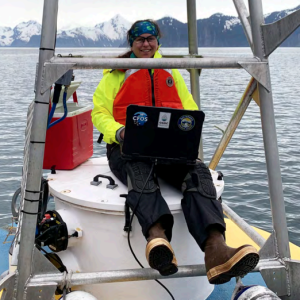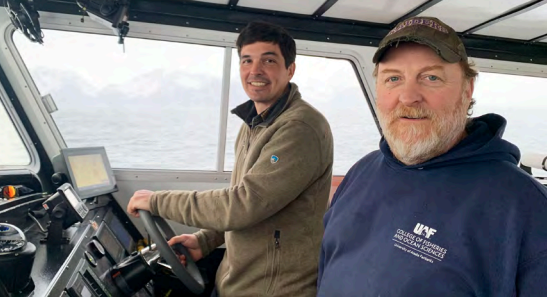Postcard From The Field
Buoy Ride In The Gulf of Alaska
By Natalie Monacci

from the Gulf of Alaska Ocean Acidification
(GAKOA) surface mooring in Resurrection
Bay after equipment replacement in May
2023.
The Gulf of Alaska Ocean Acidification surface buoy, known as GAKOA, has been monitoring surface seawater carbon dioxide (CO₂) since 2013, aiming to detect change in seawater CO₂. But behind that simple sentence, there’s a long and ongoing story of challenging fieldwork.
In the beginning — 2011— we did a trial run to test the equipment. At that time, the moored autonomous system, measuring the partial pressure of carbon dioxide (or pCO₂), hadn’t previously been deployed at a high-latitude site with freezing conditions, and we ran into a lot of technical problems. The first two years were tough! Luckily, we had a group of people at University of Alaska Fairbanks (UAF), University of Washington, and the NOAA Pacific Marine Environmental Laboratory (PMEL) that were committed to working through the engineering and design issues.
“Working through the issues” sounds nice and tidy, but in the fieldwork reality, fixing technical problems on moored systems can get pretty wild. For example, in those first two years, there were lots of what we call ‘buoy rides’. This is when we have to physically get on the floating buoy to fix or replace parts that aren’t working properly. We do this because it is too expensive to charter a ship and recover the whole mooring each time something goes wrong. “Recover” is a term we use to summarize the complicated and laborious process of bringing an entire mooring onto the deck of a ship, including the big surface float, a string of vulnerable and expensive instruments, communication cables, chain, and a very heavy anchor.
A buoy ride is much less expensive than a full-blown mooring recovery, in terms of ship and personnel time, but riding a buoy requires some fortitude, a strong grip, and reasonably calm weather conditions. This isn’t always easy in the stormy northern Gulf of Alaska, where some say the “Pacific breaks its back.”
In 2013 we moved GAKOA from an exposed location at the mouth of Resurrection Bay near Qutekcak (Seward), AK, to a more sheltered location in Sunny Cove. We had great success with the modifications we made to the equipment, and we could get reliable data year-round. This started a new trend: no more buoy rides! Or so I thought…
A ‘buoy ride’ is when we have to physically get on the floating buoy to fix or replace parts that aren’t working properly.
GAKOA and our science team had relatively smooth progress for most of a decade, but in May 2023, we hit a major snag. One critical piece of instrumentation on GAKOA failed.
We always deploy the MAPCO₂™ sensor with a “reference gas” to ensure that we have the most accurate data. Our goal is to detect the anthropogenic trend of carbon dioxide in seawater; for that, our uncertainty needs to be less than 1 μatm, or less than one one-millionth of an atmosphere (‘atmosphere’ here being a standard unit approximately equal to average atmospheric pressure at sea level). We achieve this by calibrating each measurement with the reference gas.
But in the spring of 2023, there must have been a small leak in our fittings. I had turned the buoy around (mooring-speak for a seasonal maintenance and data-download visit to the buoy) at the end of February. It was May when Sylvia Musielewicz texted me, “GAKOA’s out of gas”. The real time data transmissions are received at PMEL and Sylvia is usually the first to see any issues. Being out of reference gas means that the data GAKOA was collecting would be unusable.

At the time Sylvia told me we were no longer collecting quality data at GAKOA, I was aboard the NOAA Ship Oscar Dyson, deploying the same pCO₂ sensor on the long-term EcoFOCI mooring site in the southeastern Bering Sea (M2). So, I immediately started making plans to return to Seward after I got back from Unalaska. A buoy ride in the Bering Sea or Gulf of Alaska, no thanks… but a buoy ride in Sunny Cove, that’s doable on a nice day!
UAF’s Seward Marine Center runs the small but very capable RV Nanuq (‘polar bear’ in Iñupiaq language, and the UAF mascot!). Once I got to Seward, it was just a matter of waiting for the right weather conditions, and then we headed for GAKOA. I replaced the reference gas and quadruple-checked the fittings, like usual, for leaks. No leaks… we headed back to harbor. Another successful buoy ride in the books! They sure make for fun stories after the fact, but a buoy ride always means something went wrong, and hopefully I won’t have to do one for another ten years!
